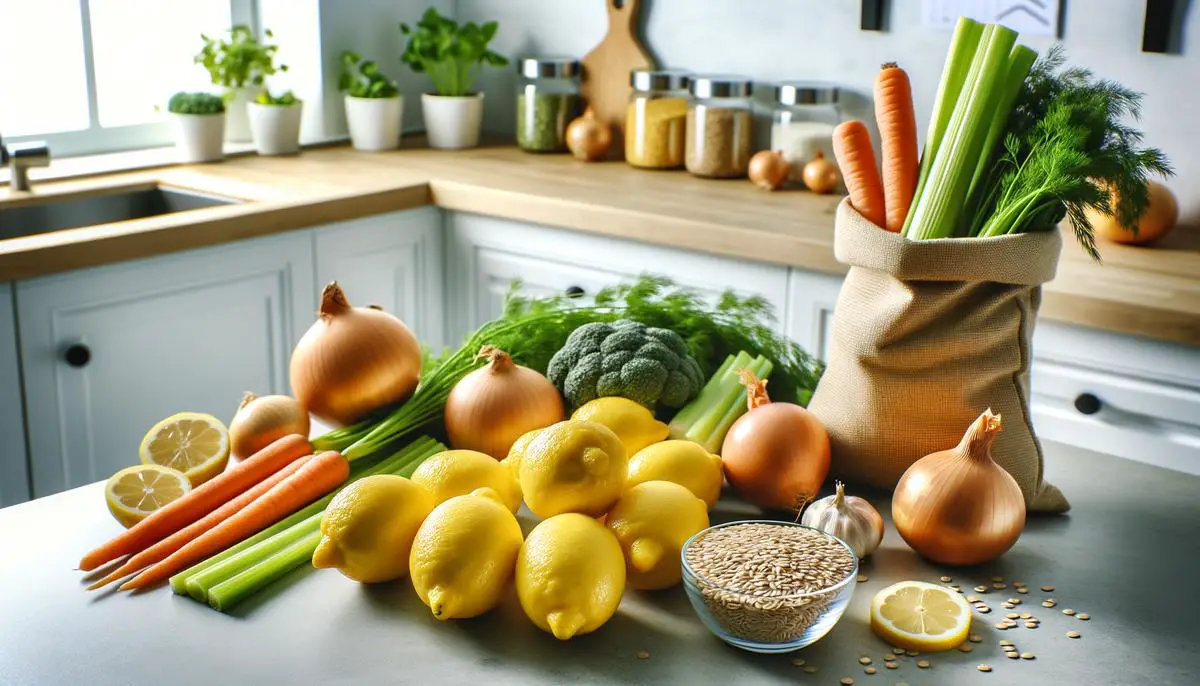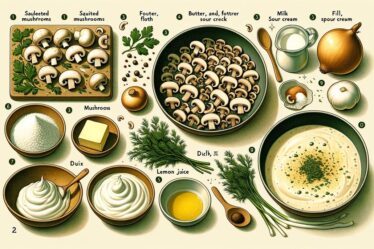
When it comes to cooking, the choices we make about what goes into our dishes matter tremendously. Opting for high-quality ingredients like fresh lemons and organic chicken broth can truly transform our meals. This article explores the profound impact of these ingredients and offers insights into techniques that enhance our culinary adventures. From the zest of a lemon to the richness of broth, every detail contributes to the creation of dishes that are as nourishing as they are delicious.
Sourcing Quality Ingredients
The Significance of Using Fresh Lemons and Organic Chicken Broth in Cooking
When preparing a dish, the quality of ingredients can transform the mundane into the magnificent. This is especially true for elements like fresh lemons and organic chicken broth, which may appear simple but are foundational to culinary excellence.
Fresh Lemons: A Burst of Flavor
Fresh lemons are a game-changer in the kitchen for several reasons. Firstly, the vibrant citrus zest adds an unmatched freshness to dishes that bottled lemon juice simply cannot replicate. Whether it’s grated over a finished dish or infused into a sauce, the zest brings a bright, aromatic quality that elevates the meal.
Secondly, the juice of a fresh lemon offers a balance of tartness and acidity that is crucial for seasoning. It can transform a heavy, one-dimensional dish into something that tastes balanced and lively. Unlike its preserved counterparts, fresh lemon juice retains a complex flavor profile that includes floral and subtly sweet notes, making it a versatile ingredient in both savory dishes and desserts.
Organic Chicken Broth: Depth and Health
Organic chicken broth, on the other hand, is a powerhouse of nutrition and flavor. Unlike many store-bought options loaded with sodium and artificial flavorings, organic chicken broth made from free-range chickens and natural ingredients offers a depth of flavor that is both comforting and robust.
This broth serves as a crucial base for soups, sauces, and risottos, providing a layer of flavor that synthetic broth products cannot achieve. The richness of organic chicken broth complements a wide array of ingredients, enhancing their natural tastes and textures without overpowering them. Moreover, the health benefits – including a higher concentration of vitamins and minerals – make it a superior choice for those looking to nourish their bodies as well as their taste buds.
Integration into Cooking
- Lemon: Always have fresh lemons on hand. Use their zest to garnish dishes, enhancing both appearance and aroma. Incorporate fresh lemon juice into dressings, marinades, and even a splash over cooked vegetables to brighten the flavors.
- Organic Chicken Broth: Replace water with organic chicken broth when cooking grains like rice or quinoa. Not only does this infuse the grains with rich flavors, but it also adds nutritional value. Use it as the base for soups and stews or to deglaze pans, capturing the delicious brown bits for a flavorful sauce.
To sum up, the decision to use fresh lemons and organic chicken broth might seem trivial, but it’s these choices that can spell the difference between a good meal and a great one. Their ability to enhance food naturally while adding nutritional benefits makes them indispensable in the quest for culinary excellence.

Perfecting Egg-Lemon (Avgolemono) Technique
Moving on to the core of achieving that perfectly silky-smooth avgolemono, a cherished Greek soup known for its comforting blend of chicken broth, lemons, eggs, and rice or orzo. Nailing this dish boils down to two critical techniques: tempering the eggs and constant stirring.
First, let’s talk about tempering. This process is crucial to prevent the eggs from scrambling when introduced to the hot broth. Begin by whisking your eggs in a separate bowl until they are well beaten and smooth. Gradually whisk in about a cup of the hot chicken broth you’ve been simmering, doing this very slowly, bit by bit. This method gently raises the temperature of the eggs, ensuring they integrate smoothly into the soup without curdling. Think of it as coaxing the eggs into the hot liquid, rather than throwing them directly into the fire.
Now, onto stirring – this is where your attentiveness pays off. Once you’ve tempered the eggs and combined them with the lemon juice, it’s time to introduce this mixture back into the pot. Here’s where you need a steady hand and patience. Pour the egg-lemon mixture into the simmering broth, and then keep the soup on a low simmer. Stir continuously but gently. This constant motion is what distributes the warmth evenly, thickening the soup into that velvety texture that makes avgolemono a standout dish. Don’t rush this step. A hurried hand leads to a less than smooth finish, and nobody wants that.
Underpinning both these steps is the choice of rice or orzo. For an optimally silky texture, opt for orzo pasta. Its small, rice-like shape blends seamlessly into the soup, offering just the right amount of body without overshadowing the delicate balance of lemon and eggs. It’s paramount to cook the orzo separately and add it towards the end of your cooking process. This way, it retains its texture without absorbing too much broth or becoming mushy.
Bear in mind, Avgolemono thrives on simplicity. Its elegance lies in its smoothness, a testament to your technique rather than the extravagance of ingredients. With the right approach to tempering and stirring, plus a judicious choice of orzo, you’re not just making a meal; you’re crafting an experience. Remember, it’s the steady hand and the patient heart that achieves the silkiest of avgolemonos.

Balancing Flavors
Balancing Acidity and Richness in Tomato Sauce
Creating the perfect balance between acidity and richness in a tomato sauce elevates it from good to unforgettable. Let’s dive into some easy techniques to achieve this harmony, focusing on ingredients and methods that tweak the balance in favor of flavor perfection.
Using a Pinch of Sugar:
Sugar is often the unsung hero in cutting through the natural acidity of tomatoes, rounding out their flavor without making the sauce overtly sweet. After simmering your tomatoes, whether fresh or canned, taste the sauce. If it leans towards the tart side, a modest pinch of sugar can transform the taste. Begin with a quarter teaspoon for a standard pot and adjust according to taste. Remember, the goal is not to sweeten but to achieve a mellow richness that complements the tomatoes’ tanginess.
Incorporating Dairy:
Dairy products like butter, cream, or even a spoonful of mascarpone cheese work wonders in softening the acidic edge of a tomato sauce. Towards the end of your cooking, swirl in a tablespoon of butter or a splash of cream. This not only infuses a silky texture but also introduces a slight sweetness and depth that balances the sauce’s acidity. For a thicker, more indulgent sauce, stir in a dollop of mascarpone cheese until it fully incorporates. These additions make the sauce harmoniously rich, highlighting the tomatoes’ robust flavor without overwhelming the palate.
Using Baking Soda:
This trick might sound unconventional, but a pinch of baking soda can neutralize acidity in a tomato sauce. Start with just a pinch for a large pot, stirring it in and allowing the sauce to simmer for a few minutes. Taste and, if necessary, add another pinch. Be cautious, though; too much can render the sauce flat and slightly soapy in taste. This method can be particularly useful if you find yourself out of sugar or are cooking for someone with dietary restrictions.
Choosing the Right Tomatoes:
The type of tomatoes you use can significantly influence the acidity of your sauce. For a naturally sweeter, less acidic sauce, opt for varieties like San Marzano or Roma tomatoes. Their lower acidity and inherent sweetness mean you might need less sugar or no sugar at all to achieve the perfect balance. Fresh, seasonal tomatoes are always a fantastic choice, though the acidity can vary. If using canned tomatoes, look for those labeled “no added acid” or “low sodium” for a more neutral base to start with.
In summary, striking the perfect balance between acidity and richness in tomato sauce revolves around nuanced adjustments and understanding the ingredients at your disposal. Whether sweetening with a sprinkle of sugar, enriching with dairy, employing a pinch of baking soda, or choosing the right tomatoes, your sauce can achieve that sought-after harmony that defines great Italian cooking. Experiment with these techniques, trusting your taste as the ultimate guide to crafting a tomato sauce that boasts a perfect equilibrium between rich depth and vibrant acidity.

Through careful selection of ingredients and mastery of culinary techniques, we unlock the full potential of our cooking. Fresh lemons and organic chicken broth are not just components of a recipe; they are the heart and soul of what makes a dish come alive. By embracing these elements, we elevate our meals and enrich our dining experiences. Let’s cherish every slice, every simmer, and every stir, for it’s these steps that lead us to a table brimming with flavors that both comfort and invigorate.



